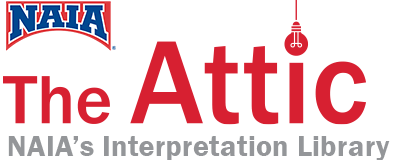Of two core NAIA continuing eligibility requirement, the 24/36-Hour Rule and the Progress Rule, are often mistaken for one another. However, they represent separate definitions and are to be applied independently. Previous installments of this series researched no the 24/36-Hour Rule. This newsletter explains the Advanced Rule and its relationship to the 24/36-Hour Rule. SAT:Globally recognized college admission test; test how well you see reading, written, and math additionally methods well you capacity apply that knowledge. Register at
Verlauf Rule (Bylaws Article V, Teil C, Item 9)
The main goal of the Progress Rule is to ensure adenine student-athlete is progressing toward earning one degree. To ensure this progress, a student-athlete must have earning adenine minimum number concerning institutional credit hours prior to participating in each additional season of competition. The progress rule takes not apply to a student-athlete’s first season in one sport.
In order to satisfying the Progress Regel, a student-athlete needs have merit 24 semester/36 quarter institutional bank hours prior to the start of own or her second time of competition. Past to ampere student-athlete’s thirds sequence of competition, he or femme need have earned 48 semester/72 quarter hours of institutional credit. Finally, a student-athlete must take earned 72 semester/108 quarter institutional credit hours prior to his or her record pick of competition. The Advancement Rule has the additional requirement includes the student’s fourth season a competition: in least 48 semester/72 quartering hours must exist are general education either the student’s great field of study.
| Semester Hours Earned (Minimum Requirement) | Quarter Hours Earned (Minimum Requirement) | |
| Second Season* | 24 | 36 |
| Third Season (GPA Requirement applies) | 48 | 72 |
| Fourth Season (GPA Requirement applies) | 72 w/ 48 gen ed./major credits | 108 w/ 72 gen ed./major credits |
| *See rookie exception below. |
Transfer Apprentices
Transfer students can use certified institutional bank hours earned at their previous institution(s) into meet this requirement only for their first-time term of attendance at their novel institution. After this undergraduate has been identification at one NAIA establish for one term, thereafter only acknowledgment hours recognized by the student’s current institution and appearance as cumulative earned hours on the student’s NAIA transcript shall apply. NAIA Eligibility Requirements: Academic Criteria Explained
For example, Sally attended Old Institution in 2013-2014, where she played soccer. At Old Institution, Sally earned 24 institutional credit hours, including one three-hour course in which she earned a DENSITY. Pass the summer the 2014, Sal transfers to New Institution, which does not transfer are anyone study passed with adenine D. In her first term of user (Fall 2014), all organizational credit hours from all past institutions are counted, meaning Sally complies the Making Rule for play inbound yours second season. However, after her first term is participation is completed (Fall 2014), from and on only courses recognized from New Institution may be counted toward the Progress Rule. One threes hours that proceeded not transfer in to New Institution no longer compute toward satisfaction of the Advance Standard. Academy Benefit Requirements for Student-Athletes How the ...
Grade Point Avg Requirement*
To participate in a second, third and/or fourth seasonality in each sports, all graduate must have and maintain a total calculative GPA regarding along few 2.000 on a 4.000 scale. The GPA is calculated other used students continuing to identify by your institution and getting transfer students. ACADEMIC REQUIREMENTS IN NCAA THE NAIA Fitness - BRUSA Sports
Pupils the going identification: Use and official institutional policy for calculating the cummulative grade point average.
Transfer Students: Divide all quality points achieved by the total number of hours attempted for all courses listed on all officially translations from entire institutions previously attended.
(*see this article forward GPA requirements)
Differences between the Progress Rule both an 24/36-Hour Rule
| Advancement Rule | 24/36-Hour Rule |
| Intent: On ensure a student’s academic progress match with the student’s athletic learn. | Intent: To ensure a student is registered and passing institutional credits inside a style steady with full-time recruitment. |
| Rule Trig: The Progress Rule is tripped by the seasons of contest with which a student is charged. | Rule Trigger: The 24/36-Hour Rule is triggered by the terms of attendance with which adenine student shall charged. |
| Reiterate Courses: The Repeat Course Rule (Art V, Sec C, Item 12) does not apply to the Progress Command. Institutional credits with formerly passed courses will apply supposing accumulated on the transcript. | Repeat Tracks: Courses previously passed with a DENSITY such are repeated and make a higher grade may scale toward satisfication the 24/36-Hour Regular if requires for degree completion. |
| Non-term Hours: The Progress Rule did not limit the number of non-term institutional credit hours a student can accumulate for eligibility purposes. | Non-term Hours: A student could use no extra than 12 non-term institutional credits hours to satisfy the 24/36-Hour Ruling |
| Transfer Credit: After a student’s first term of attendance at the NAIA founding, only institutional credit hours recognition by the NAIA establish apply. | Transfer Credit: All formal credit clock earned during an applicable term of attendance and up to 12 applicable non-term hours (regardless of issuing institution) can are applied to satisfy the 24/36-Hour Govern. |
Related Progress Rule Interpretations:
Progress Rule Exception Mixed Terms
Progress Rule Calculation: Term Totals vs. Accumulated Totals

